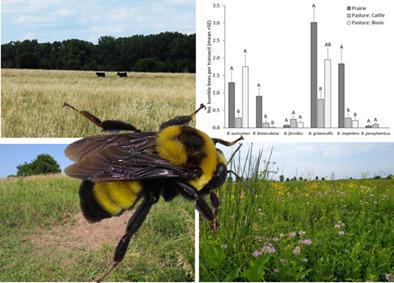当前位置:
X-MOL 学术
›
Insect Conserv. Divers.
›
论文详情
Our official English website, www.x-mol.net, welcomes your
feedback! (Note: you will need to create a separate account there.)
Native and agricultural grassland use by stable and declining bumble bees in Midwestern North America
Insect Conservation and Diversity ( IF 3.2 ) Pub Date : 2020-09-18 , DOI: 10.1111/icad.12448 Derek W. Rosenberger 1 , McKenna L. Conforti 1
中文翻译:

北美中西部稳定和下降的大黄蜂对本地和农业草原的利用
更新日期:2020-11-18
Insect Conservation and Diversity ( IF 3.2 ) Pub Date : 2020-09-18 , DOI: 10.1111/icad.12448 Derek W. Rosenberger 1 , McKenna L. Conforti 1
Affiliation

|
- Bumble bees are important pollinators in both natural and anthropogenic systems. In recent years, some species have suffered declines, including in the American Midwest. While loss of floral resources and grassland habitat may contribute to these declines, little is known about how native versus agricultural grasslands affect bumble bee populations.
- We conducted 3 years of bumble bee population and floral use surveys across restored tallgrass prairie, bison pasture, and cattle pasture in Northern Illinois.
- We found 1.75–3.5 times more bumble bees in native plant dominant tallgrass prairie than in exotic‐dominant pasture sites. In addition, bumble bees were two times more abundant in bison pasture than in cattle pasture. Bumble bee species richness was approximately 1.5–2 times greater in prairie, while richness was comparable in the two pasture sites. Habitat‐dependent abundance and richness were driven by individual bumble bee species habitat preferences.
- Across habitats, native Monarda fistulosa was highly favoured by foraging bumble bees, particularly by the regionally declining B. auricomus. In the absence of native species, exotic Trifolium pratense and Daucus carota were important forage sources in pastures.
- These results indicate that grassland management practises to shift grassland plant communities towards native‐dominant over exotic‐dominant communities may strengthen bumble bee populations, although these effects will likely be Bombus species‐dependent. Our findings highlight the need to understand the impacts of habitat on specific bumble bee species, as this will be critical in developing conservation plans for declining populations now and in the future.
中文翻译:

北美中西部稳定和下降的大黄蜂对本地和农业草原的利用
- 大黄蜂在自然和人为系统中都是重要的传粉媒介。近年来,包括美国中西部在内的一些物种的数量下降。虽然花卉资源和草地栖息地的丧失可能是造成这些下降的原因,但人们对原生草原和农业草原如何影响大黄蜂种群的了解却很少。
- 我们对伊利诺伊州北部恢复的高草草原,野牛牧场和牛牧场进行了3年的大黄蜂种群和花卉利用调查。
- 我们发现,本地植物优势高草草原上的大黄蜂比异国情调的牧场高1.75–3.5倍。此外,在野牛牧场中,大黄蜂的数量是在牛牧场中的两倍。大草原上的大黄蜂物种丰富度大约是大草原的1.5–2倍,而两个牧场的丰富度可比。生境依赖性的丰富度和丰富度是由单个大黄蜂物种栖息地偏好所驱动的。
- 在整个栖息地中,瘘口的Monarda fistulosa受到觅食大黄蜂的青睐,特别是受到区域性下降的B. auricomus的青睐。在没有本地物种的情况下,外来的白三叶和胡萝卜茎叶是牧场中重要的草料来源。
- 这些结果表明,尽管草地管理的做法可能会导致熊蜂种群依赖,但将草地植物群落从本地优势种群转变为外来优势种群的草原管理实践可能会增强大黄蜂种群。我们的发现强调需要了解栖息地对特定大黄蜂物种的影响,因为这对于为现在和将来的人口下降制定保护计划至关重要。











































 京公网安备 11010802027423号
京公网安备 11010802027423号